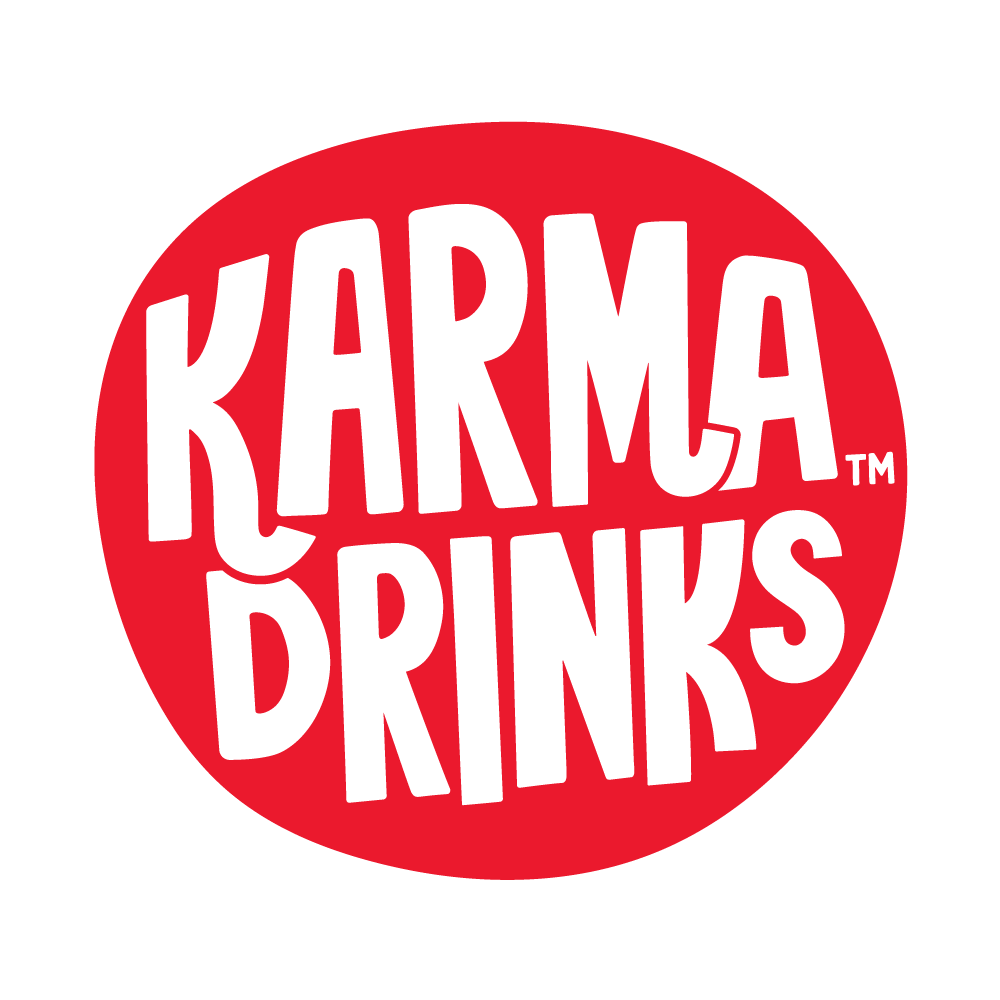Board Meeting Minutes - The Ultimate Guide
- Chapter 1: All you need to know to make your meetings minutes stand out
- Chapter 2: Why board meeting minutes are key
- Chapter 3: Who is tasked with taking meeting minutes?
- Chapter 4: Writing effective board minutes
- Chapter 5: Recorded Webinar - Creating Effective Minutes for your Board Meetings
- Chapter 6 Tips for writing effective meeting minutes
- Chapter 7 Everything you need to know about minutes
All you need to know to make your meeting minutes stand out
Meeting minutes serve as the official record of Board meetings. They provide a history for the Board’s members, both for professional and personal reference purposes and for legal reasons such as protection against liability. They are a vital aspect of Boardroom functioning, valuable to both executives and directors alike. Meeting minutes provide proof of decisions made by Board members and record decisions made within meetings and any duties assigned.
While meeting minutes may be daunting if you are new to implementing them within the company, having a clear idea of how they should be laid out and utilised can streamline both Board meetings and the post-meeting process. It is important to be sure that you are following best practices when creating meeting minutes, as they carry legal weight for the company. Below, we have outlined the most common challenges regarding meeting minutes, as well as how best to avoid these issues and make use of a key Boardroom tool.
Interested in a free meeting minutes template? Click here to download ours and get started:
Other interesting articles
Why board meeting minutes are key
Meeting minutes attest to a Board meeting having taken place. They serve as an official record of all business meetings and Board discussions. Our memories of meetings can be faulty, whether due to our own biases and agendas or simply because, as people, we are prone to forgetting details – meeting minutes help fill in the gaps and act as an objective guide of what really occurred in the Boardroom. When compiling the minutes, the Corporate Secretary’s job is to combine observations from the meeting by listening and recording so that they can then compile the discussions into a clear and concise written record for the whole team.

Meeting minutes are a valuable tool for all members of the Board. They prove that management is fulfilling their promised duties, as well as documenting that directors are acting in the best interest of the company by maintaining a record of their decisions and the discussions leading up to such choices.
Because meeting minutes cover so much information, they can easily grow into lengthy documents that take days to compile. It is important that, no matter how monotonous or run-of-the-mill a meeting may seem to outside eyes, the Company Secretary is able to remain focused and alert, capturing the key information of the meeting and what sets it apart in the stream of business. They must remain objective as they listen, synthesise, and record the proceedings. The Company Secretary plays a vital role in the organisation’s functioning: they build the record that protects the company against legal action, stands as the company’s history, and guides them into the future.
It can be helpful to emphasise the Secretary’s standing within the company as they write the meeting minutes. Consider citing the by-law, policy, or other sources that give them the authority to create the minutes so that their value is recognised by the whole team.
There are many ways in which to create meeting minutes, and generally, the format will differ company-to-company. Meeting minutes should be highly individual to your company and tailored to your team’s specific needs and objectives. You should be aware of your team’s capacity to maintain the style of meeting minutes you have selected: you want to remain consistent, clear, and concise above all else.
If your company is smaller, you may not have the manpower or time to dedicate independent resources to meeting minutes. It can help, then, to choose a more bare-bones format that will take up less of your time until your company has grown and can justify fancy presentation formats, multilingual versions, or ‘nice to have’ content, such as paragraph flags that provide background information for each decision item. Stick to the ‘must have’ items for your organisation, adding extras as you can, and you will have a successful format for your meeting minutes.
Who is tasked with taking meeting minutes?
The person responsible for meeting minutes within your company will vary with the size and scope of your organisation. For example, in a larger organisation, you may have the staff to designate a specific role to create meeting minutes, such as a company secretary. At the same time, the notes may be drafted by governance or administrative staff.
In a smaller company or NFP where resources are more limited, it may be the CEO or Executive Director themself who drafts the minutes or approves the draft after their Executive Assistant completes most of the work. Need a hand getting started with your meeting minutes?
Download our free template here.
Looking for a refreshingly simple way to take your meeting minutes?
Watch this short overview to see how BoardPro’s Minute taking feature will save you hours of time and ensure that your entire board is on the same page.
Writing effective board minutes
There are many factors to consider when creating effective meeting minutes. Most often, these will depend on your industry and the specifics of your organisation. However, some broad aspects of meeting minutes are also essential, no matter the size and style of your company.
The three basic elements of creating effective meeting minutes are formatting, attendance, and body content. These three elements are crucial as they protect against liability, evidence decisions, and provide a clear list of the actions planned within the meeting. It is vital that your minutes contain some form of these three elements.
Format
In their most basic form, meeting minutes should begin with an official header, outlining the date, time, place, and type of meeting. If you have time and the resources available, you may choose to include your organisation’s logo and branding, a statement about confidentiality/security, or notations that are particular to your company. These can all help take your minutes to the next level. Whatever you choose to include, be sure to use the same format consistently for all the meeting minutes you create.
Attendance
Attendance may seem like an obvious thing to include within meeting minutes and hardly worth commenting on, but documenting attendance isn’t just an administrative exercise; it can have real legal implications in the future. Keeping a record of who and who was not present in a meeting makes clear who weighed in when decisions were made and who was unaware or excluded. If your company falls under legal questioning at a later date, this kind of record can serve as evidence within the case. Accurate attendance records are also important from a tracking perspective internal to the company. It can help you determine who is truly invested and who has perhaps fallen victim to overboarding. Investors and/or other stakeholders may also be interested in attendance to verify that their leaders are attending and contributing as they say they are.
Your attendance record can be simple, but you should be sure to include the names of both those who were present and those who were absent. Be sure to note as well if anyone is participating remotely. Job titles may be included – the more robust the corporate record, the easier it will be when someone requests research into the historical board records – but these are not essential.
You may bridge the attendance section of the meeting minutes and the body record with an Opening Meeting paragraph that notes the time the meeting begins, the person in the Chair, and the person taking minutes. These again can help establish best practices being followed or errors on the company’s part, should legal matters arise, and should as such be recorded with care.
Body
Generally, the body section of meeting minutes is split into two halves: the administrative portion and the substantive business portion. The administrative portion will generally move quickly, as Board members approve the agenda, the record of the previous meeting’s minutes and the consent agenda (if in practice in your organisation).
(A Consent Agenda can save time within meetings as it concisely covers routine business, requiring only one motion from the Board. It’s usually made up of unremarkable, standard administrative items that do not warrant debate.)
The second half of the body of the meeting minutes is the substantive business section. This includes items that require decisions and discussion, necessitating time for the Board to weigh in. This might include items such as the approval of the financial statements, endorsement of new service or product initiatives, risk management briefings, or reports from committees requiring Board approval.
The body section of your meeting minutes may, of course, be customised according to your organisation. This section also allows for the variance for particular types of meetings or your Board’s annual work plan. You may choose to include an annual strategy session, presentation from senior staff, or briefing from outside experts here, but you should differentiate this section with special formatting to separate it from the consistent formatting of the rest of your minutes.
Every item within your meeting minutes should comprise its own paragraph with a heading or rubric. All decisions made within the meeting must be included, or if no specific action was taken, the discussion should be noted. Any other actions undertaken at the meeting, such as briefings, should also be recorded. Background information may prove a valuable addition to your meeting minutes, including anything of note that serves to contextualise the contents of the discussion. Of note, decisions requiring documentation include informal agreements of general consent, regular motions, and formal resolutions by Board members: it’s better to over-record than leave out a key decision and face legal repercussions later.
Meeting minutes should aim to focus on what was done, not what was said by individuals at a Board meeting. This is to avoid pointing fingers and blame, as well as a subjective tone of the recording. Unless a Director or the Chair requests it, it is not necessary to name individuals in discussions. However, the contents of the discussion should still be recorded. Best practice calls for the use of consistent formats, language, and procedures at every meeting, including time notations when important or divisive topics are discussed – the time notation against the agenda gives future readers an idea of how long the discussion continued. All of these aspects may be key in establishing a Board’s due diligence in the performance of its duties.
Recorded Webinar - Creating Effective Minutes for your Board Meetings
Learn why the preparation of board minutes is a vital component of directors’ responsibilities, and what good minutes contain. Click here to watch the recording of the webinar.
Are you taking the preparation of your minutes seriously and do you know why you should?
Inquiries into organisational misdeeds and collapses invariably point to the shortcoming in board meeting minutes that might otherwise have explained and justified the decisions directors had taken. That scenario underlines only one of the reasons for the importance of having a thorough record of the board’s deliberations.
Key Learnings
Learn how can you can create board meeting minutes that capture every key detail without writing a complete transcript?
- Use your board meeting agenda as a template
- Who to assign as the board meeting minute taker
- What should (and should not) be recorded in your minutes
- How to write minutes in an objective tone
- How to proof read and share minutes securely
This webinar is aimed at boards, board secretaries, executives and the staff who advise and support board work.
Tips for writing effective meeting minutes
Who: Creating a record of who was present at a Board meeting (and who was not) is one of the most important parts of minutes; it demonstrates the directors are meeting their fiduciary duty.
What: Minutes should record all actions from the meeting, from the ideas stage through to completion or rejection. Minutes provide answers for what was discussed, the reasons decisions were made, and which action items will be completed moving forward.
Style: Meeting minutes should be clear and professional, as well as accessible and devoid of industry speak.
Polishing your meeting minutes
Although you may be tempted to procrastinate meeting minutes, as they are seen as a tedious and time-consuming task, it is important to tackle them head-on due to their vital record and support role they play in the functioning of the company. With the right set of tools, meeting minutes can become a familiar, recurring task that no longer evokes dread. Consistency is key to establishing both this familiarity and streamlining of the process, and this will allow you both to work quickly and reference across records with ease, building on past work in an informed way for the future.
The final task before the meeting minutes are complete is the signing of the minutes. This formalises the minutes as an honest and objective record of the meeting’s events. The Company Secretary (or team member filling this position) plays a vital role in certifying the accuracy and upstanding nature of the minutes. Depending on your organisation, the Board Chair may also sign the minutes, but they should not do this until after the Company Secretary has signed them to ensure that they are signing the correct and final version.
How BoardPro can help
BoardPro Minutes Builder exists to help unify your workflow, allowing you to create and access meeting minutes directly within your BoardPro account. Take notes, record decisions (which are then automatically compared with your BoardPro decision register), and set actions against key items (which can be followed up by BoardPro workflow rules). BoardPro Minutes Builder streamlines the creation of meeting minutes, allowing you to focus on the meeting itself.
The BoardPro home page contains a complete archive of your meetings, agendas, Board packs, and minutes so that they are easily accessible for your convenience.
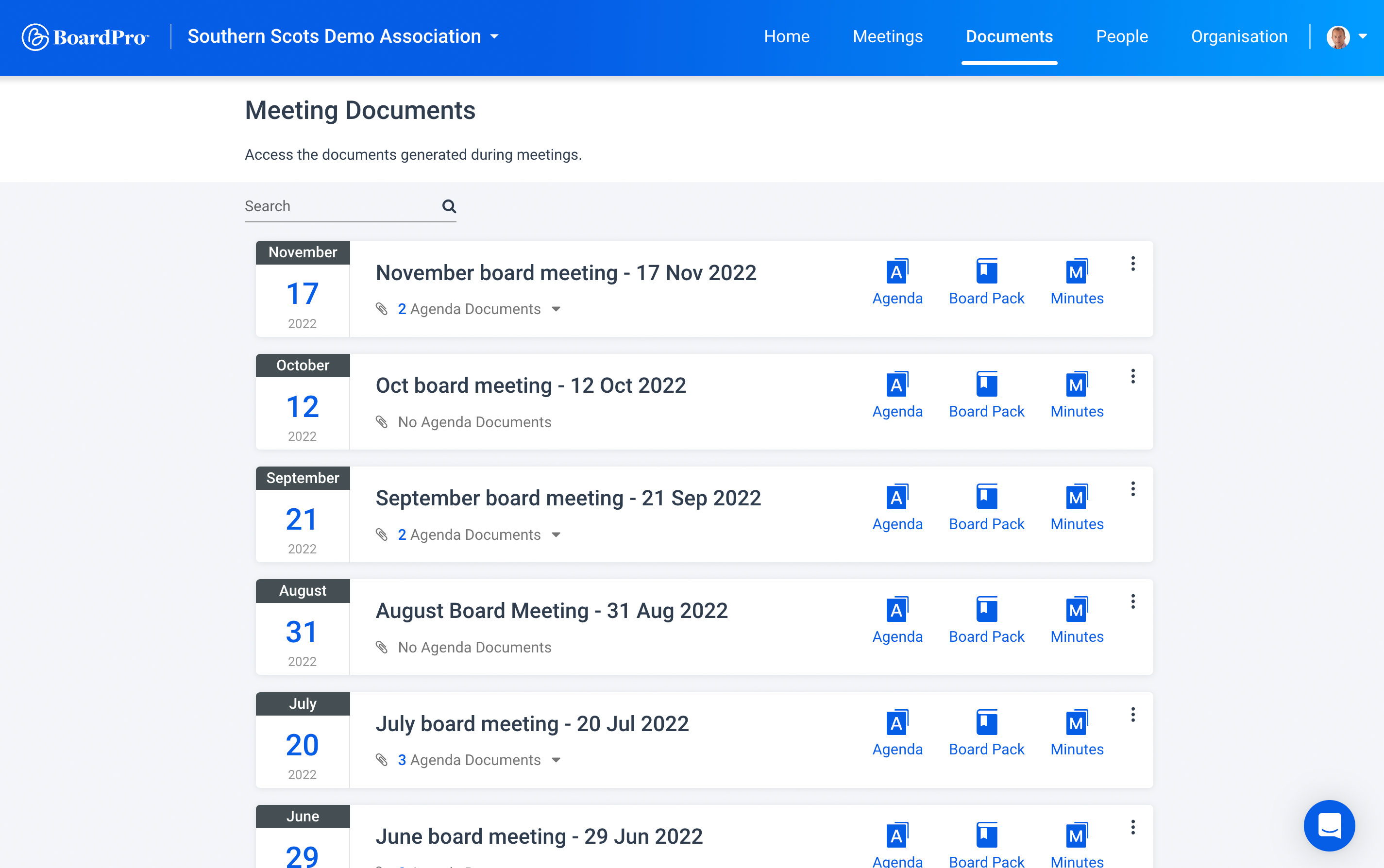
When you’ve finished reviewing your minutes, BoardPro helps you quickly publish them directly within the meeting documents section as a secure pdf. Additionally, BoardPro automatically makes these minutes available for confirmation at your next meeting, bringing the process full circle.
Governance made easy
Imagine board meetings with everything in one place and everyone of the same page.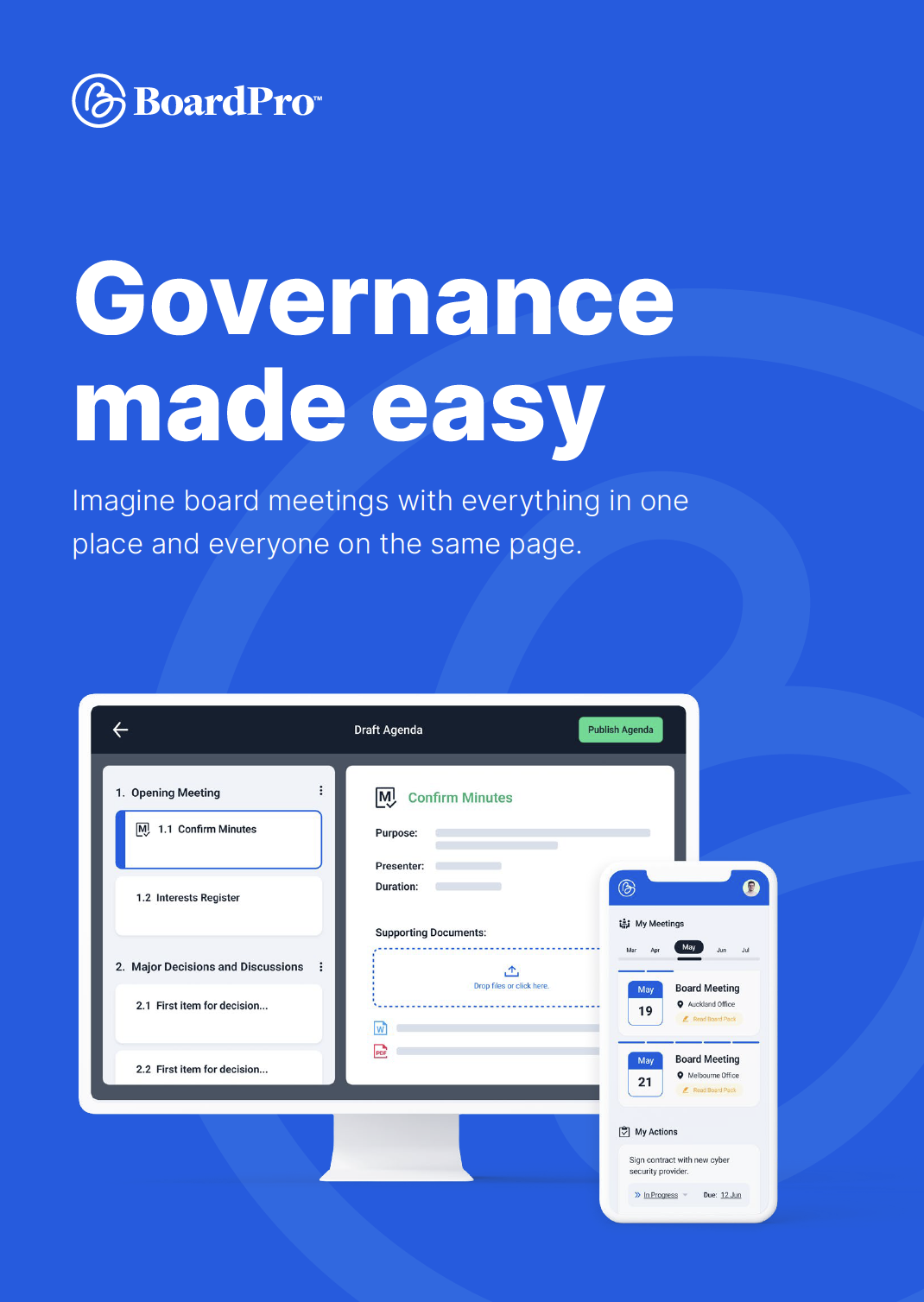
Everything you need to know about meeting minutes
Meeting Minutes serve as the official documentation of what occurred during a specific meeting. They serve as protection against potential liabilities, provide proof of decisions made, and create a clear list of actions and next steps. Minutes are essential for both executives and directors as they not only demonstrate that management has provided the necessary information for directors to effectively oversee the organization, but also show that the directors have fulfilled their responsibility to make decisions that support the organization's success.
When someone is first tasked with taking Minutes, they may lack formal training or support. However, by learning on the job, there is a risk of making mistakes with legal consequences. To avoid this, we will address common questions about Meeting Minutes, provide a template, and offer helpful tips to improve the effectiveness of your minutes. Download our Meeting Minutes template here .
Why meeting minutes are so important
The question of whether a meeting truly took place without documented Minutes can weigh heavily on the mind of a Corporate Secretary. Meeting attendees may claim to have a clear understanding of decisions made, but their recollections may differ from one another. Meeting Minutes serve as a tool to eliminate such discrepancies by providing a clear and concise record of the meeting's proceedings.
As the Corporate Secretary, it is crucial to use professional skills to listen, document and summarize discussions in the form of Minutes. These Minutes play a vital role for both executives and directors, as they not only show that management has provided the necessary information for directors to effectively oversee the organization, but also demonstrate that the directors have fulfilled their responsibility to make decisions that support the organization's success.
Being a Corporate Secretary can feel monotonous, with meetings blending together. However, there is a great deal of importance in the skill of listening, summarizing and recording proceedings in a neutral and standardized way. Instead of thinking of taking Minutes as a weakness, recasting the role as an architect who designs a cohesive narrative can shift the mindset. The Corporate Secretary not only takes notes but also creates a framework that protects against liability, evidences decisions and provides a clear list of actions for follow-up.
It's worth mentioning the authority of the Corporate Secretary in writing the minutes, which can be referenced from by-laws, policies or other sources. There is no one-size-fits-all for formatting or structuring Minutes and it should reflect the needs, culture, and style of the organization and its board. Resources play a critical role in this process, and it is essential to evaluate what is truly important for the organization and prioritize accordingly.
“Meeting Minutes are essential for both the executives and directors as they serve as a record of what occurred during the meeting. They provide evidence of the information that management has shared with the directors, enabling them to provide effective oversight and make decisions that support the organization's success. Additionally, Minutes also document that the directors have fulfilled their duty to make decisions that will guide the organization effectively.”
Who is responsible for taking the minutes?
The responsibility for meeting Minutes can vary depending on the organisation. In a larger organization, there may be a designated corporate secretary who oversees the minutes process, but the task of drafting the actual notes may be handled by other governance or administrative staff. Conversely, in a smaller business or non-profit, it may fall to the CEO or Executive Director to draft or approve the minutes after they have been completed by an Executive Assistant. If you're in need of assistance with creating meeting minutes, consider downloading our guide and a free template to help you get started
Why meeting minutes are so important
Meeting Minutes are a vital tool for all organizations, and there are specific components that are considered essential. While additional requirements may vary depending on the industry or business sector, there are three key elements to creating effective meeting minutes. The formatting of the Minutes, the attendance list, and the body of the minutes itself. All three are crucial in ensuring that the minutes perform their intended function, which includes protecting against liability, providing evidence of decisions made, and establishing a clear list of actions and next steps.
Structure
The structure or format of the Minutes is an essential element in ensuring their effectiveness. At the bare minimum, Minutes should include a header that clearly states the date, time, location, and type of meeting. To enhance the information provided and add context, consider incorporating elements such as the organization's logo and branding, a statement about confidentiality or security, and notations that reflect the organization's established practices. It's important to ensure consistency in format throughout all minutes.
Attendance
Attendance is a critical component of meeting Minutes. Keeping accurate records of attendance isn't just a matter of administrative convenience, but it also serves as important evidence in case of litigation or other issues. The attendance list should clearly indicate which directors were present and absent when decisions were made. Accurate attendance records also provide insight into directors’ attendance habits and whether they are fulfilling their duties and obligations.
Include as much detail as possible while taking the minutes, such as names of attendees and absentees, and those who participate remotely via telephone or videoconference. Including titles can also be helpful. It is important to note that more robust corporate records make it easier to research historical board records when requested.
After attendance has been recorded, the main body of the minutes should begin with an "Opening of Meeting" paragraph that notes the time the meeting began, the person in the chair, and the person taking minutes.
Body
The body of the meeting minutes typically includes two main sections: administrative and substantive business. Administrative business typically includes approval of the agenda, approval of previous minutes, and perhaps approval of a consent agenda (if used in your organization). A consent agenda covers routine business that the board can acknowledge with one motion, saving valuable meeting time for more substantive topics. These agendas usually consist of recurring or administrative items that aren't expected to generate discussion or debate, such as updates from volunteer or advisory committees, regular reports, and notices.
Substantive business, on the other hand, covers items that require more robust oversight, discussion, and/or decision, such as financial statements, new service or product initiatives, risk management briefings, formal resolutions, and reports from standing committees. Additionally, the minutes may include a special component depending on the type of meeting and the board's annual work plan, such as annual strategy sessions, presentations from senior staff, or briefings from outside experts. Each item in the minutes should be preceded by a heading or rubric, and include a record of any decision made or if no specific action was taken, a note that the item was discussed or a briefing was received. If time and resources permit, background information can be added.
It is important to practice creating evidence with consistent formats, language, and procedures at every meeting. Time notations can be included when important or divisive topics are discussed, giving future readers an idea of how long the discussion continued. This can be useful for showing the board's due diligence in the performance of its duties. Also, It is essential to differentiate the substance of the minutes with special formatting when needed. As a general rule, the minutes should reflect what was done, not what was said by individuals. It is rarely necessary, unless requested by a director or the Chair, to name an individual Director in the Minutes, unless specific questions are asked during the meeting in that case noting that questions were asked with a list of the subjects inquired about would be sound practice.
“Meeting minutes usually consist of two main sections: administrative and substantive matters. The administrative section covers routine business such as approval of the agenda and previous minutes, while the substantive section deals with items requiring more in-depth discussion and decision-making.”
How to finalise your board meeting minutes
Writing meeting minutes can often be viewed as a tedious task that is put off for another day. However, with a structured approach and consistent formatting, it can become a manageable recurring task. One way to streamline the process is by using the previous year's minutes as a template and updating them with new information.
Using consistent formats throughout the year can make it easier to set up draft versions of the minutes for the next year. The main outline, headers, and format should always remain similar, making it easy to cut and paste information from previous minutes into the current year's version.
Before the minutes can be used as official evidence of the board's proceedings, they need to be signed by the Company Secretary (or someone of similar position), who certifies that the record of proceedings is accurate and reflects the discussions and decisions of the board. In some organizations, the Board Chair may also sign the minutes. A good practice is for the Board Chair to not sign any minutes until after the Company Secretary has signed them, ensuring that the Board Chair is signing the correct version.
Governance made easy
Imagine board meetings with everything in one place and everyone of the same page.
Top tips
Meeting minutes are a critical record of the decisions and actions taken during a meeting. To ensure that your minutes are effective, there are a few key tips to keep in mind
- Record attendance: One of the most crucial elements of minutes is documenting everyone who was in attendance. This serves as important evidence of the directors' fulfillment of their fiduciary duty
- Keep track of actions: Minutes should document every action that is taken, from its inception to its completion or abandonment. This helps to provide a clear understanding of the decisions and actions that were taken during the meeting
- Include the what, why and how: The minutes should answer the questions of what was discussed, why decisions were made, and what action items will be completed in pursuit of those decisions. This helps to provide context and understanding of the meeting's proceedings
- Make the minutes readable: Avoid using acronyms, jargon, or industry-specific language in your minutes. Use clear, concise language to make the minutes easily understandable for anyone who reads them.

From Our Blog
Stay up to date with what is new in our industry, learn more about the upcoming products and events.

Going paperless: tips for transitioning to a board portal

Board reviews: 3 techniques to evaluate your board’s performance

The CEO performance appraisal: aligning feedback, KPIs, and strategic goals
Thousands of boards around the world trust BoardPro
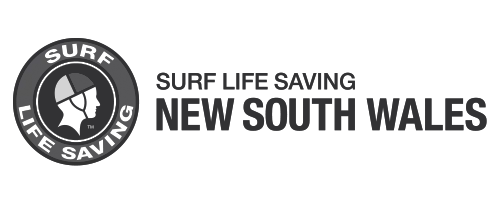



.png?width=100&height=100&name=master-builders%20(2).png)

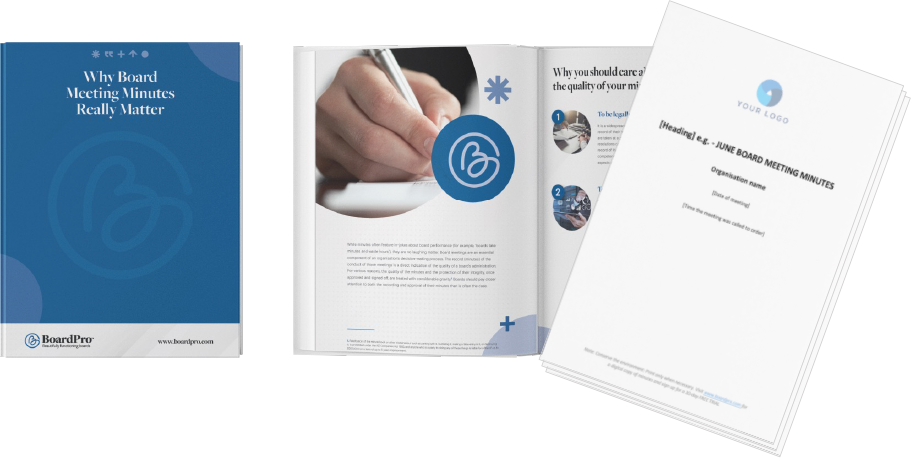

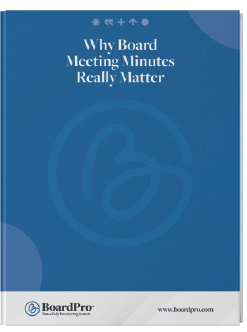
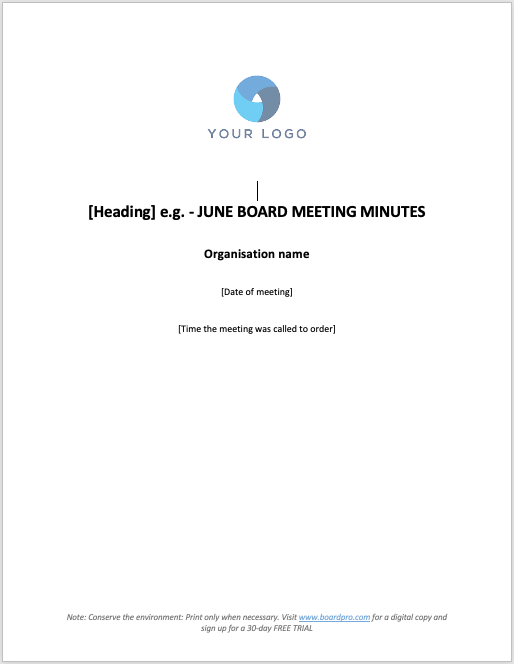

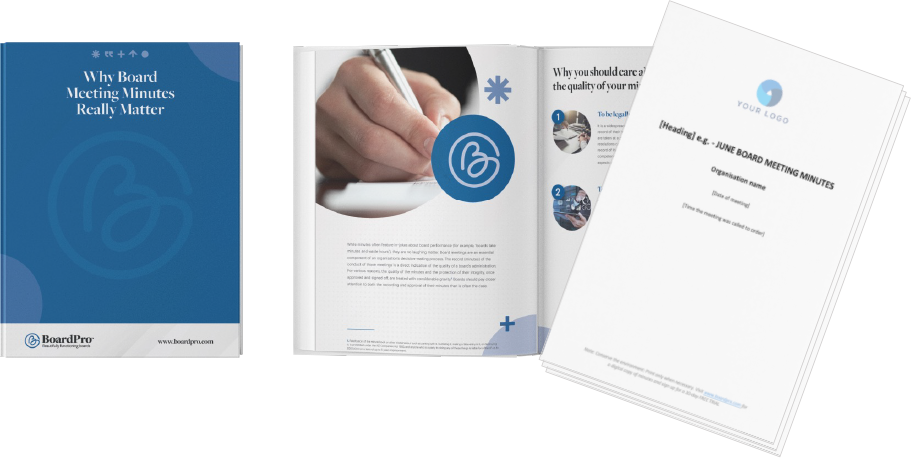


.png?width=760&height=760&name=Patrick%20(1).png)
